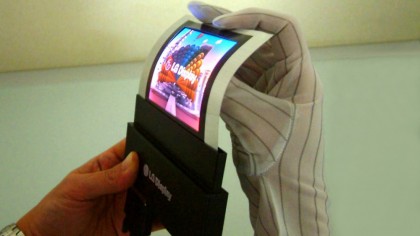Want to know when your phone will become your flexible friend?
Will pliable displays ever take off?
Wait - there's a problem
But can a flexible display offer anything approaching the resolution and clarity as seen on the stunning HTC One and Samsung Galaxy S4?
"It's very difficult to have high definition screens that are also bendable and flexible," Professor Andrea Ferrari from Cambridge University told us. That's because of current technology limitations.
LG Display already demonstrated an unbreakable and flexible 5-inch plastic OLED panel for mobile devices that was labelled as HD, but it's unlikely that early flexible displays will match their rigid counterparts when it comes to pixel density.
Raza Ali, IT & Telecom Analyst at Visiongain, added: "The flexible screens in early devices will not be as good as traditional glass OLED initially. However, the quality will get better with time and eventually surpass glass OLEDs."
Making everything else flexible
There's also the issue of the myriad other components needed to enable a bendy phone or tablet. It's fine for the display to flex, but if the battery and other components can't do the same, then how can we ever expect progress here?
That's what makes the recent developments with graphene so exciting. This flexible carbon is extremely strong and could be used to make the display and the rest of the components in a smartphone flexible as well.
Professor Ferrari told us that graphene is the "strongest and most stretchable material, flexible and bendable, transparent and conductive," going on to explain that "these properties are ideal for interactive displays."
Get daily insight, inspiration and deals in your inbox
Sign up for breaking news, reviews, opinion, top tech deals, and more.
Plastic Logic is already using the material to overcome the barriers to flexible screens, working with the Cambridge Graphene Centre to overcome the inherent issues.
"Plastic Logic is working with new materials which will help make batteries flexible and energy-dense enough to power these flexible display screen devices" according to Ali, explaining that "there will be a whole new submarket working on subsidiary electronic components needed for flexible display devices. There is a lot of research and development going on... to make truly flexible display devices a reality in the near future."

As for the touchscreen, we are used to glass, and plastic simply doesn't have the same feel. Luckily the makers of Gorilla Glass, Corning, are already working on something called Willow Glass which is flexible and (according to Corning) "formulated to perform exceptionally well for electronic components such as touch sensors".
This material will even allow electronics to be printed directly onto the substrate and combined with the glass all in one manufacturing process - another big advantage that OLED technology has, as it can be printed in a variety of ways.
But will anyone be able to afford a flexible phone?
Cost is always a consideration with new technology - OLED TVs are a brilliant idea, but have been hampered for years by eye-watering price tag.

Ali suggested "the biggest challenge to be faced by OEM's in the flexible display screens market is balancing the performance and the price of the product to ensure premium user-experience and the best value for money at that price point."
He states they will be "high-end and luxury consumer devices for early adopters", and it could be 2018 before the costs fall significantly enough to entice the new smartphone buyer to splash out on a new device.
But, like LCD and plasma TVs in the last decade, identifying new materials and fine-tuning the manufacturing process will bring costs down over time to a price people are comfortable with.
When can I buy a smartphone with a flexible display?
But don't think the iPhone 5S will be a wibbly wonder. Predictably, it will be some time before the full potential of the technology can be realised.
Professor Ferrari believes "[displays] are becoming less and less of a science issue, and more of a development and marketing decision," so we could see smartphones using graphene in the display within a year or two.